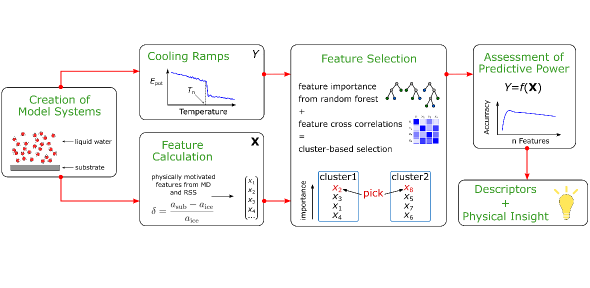
22/09/2020
Ice nucleation is the process of liquid water freezing into solid ice. In nature, it happens almost exclusively via the help of foreign materials, which influence interfacial water molecules and trigger the nucleation event. Without these impurities, pure water can easily remain liquid down to minus 40˚C and beyond. Despite the very first ideas about what surface characteristics cause this nucleation enhancement already emerged in the late 1940s, to date we still cannot predict which type of substrate will inhibit or promote ice crystallization with quantitative accuracy.
In this work, the researchers shed light onto the issue of predicting the ice nucleating ability (INA) of substrates by utilizing their growing database of systems characterized by means of coarse-grained molecular dynamics simulations. Instead of traditionally seeking what surface properties correlate with the INA they developed a data-driven workflow that selected from a large corpus of surface and interfacial properties the relevant ones. The method combines machine learning and information theory to balance predictive power and cross-correlation during the property selection. With this, they were able to predict the INA of unseen substrates in their database. Beyond rediscovering the known descriptor of the lattice match between ice and the substrate, three more important properties were identified. Using all four, predicting the INA could be done twice as accurate as the state-of-the-art.
This is the first time that such a prediction of the INA has been demonstrated. Even though much work refining the findings into direct experimental measures and generating data with more accurate simulations methods is ahead, this research marks the start of the age of quantitative prediction for the heterogeneous (ice) nucleation community.
